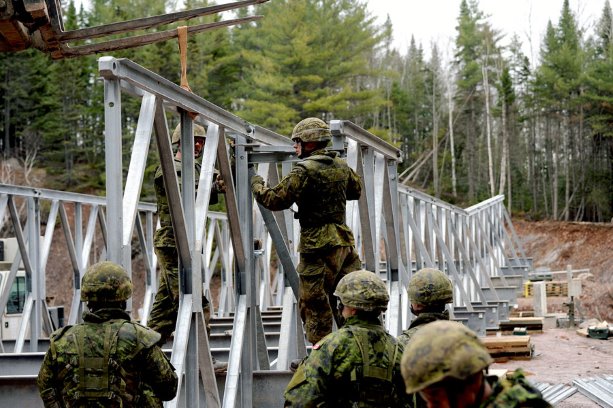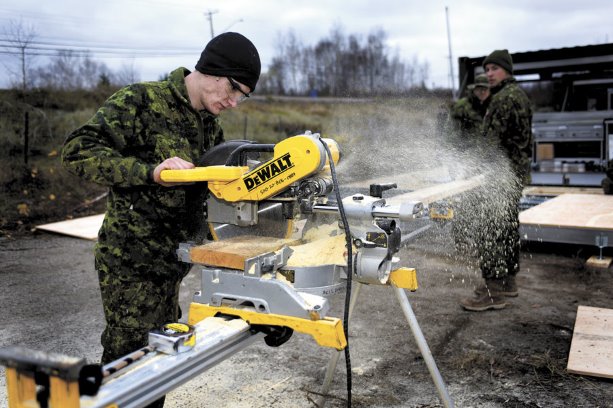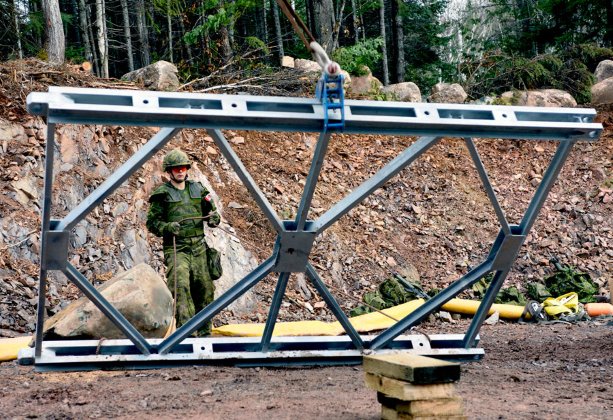This is the first of a two-part Daily Commercial News series exploring military construction and engineering training exercises that are being conducted across Canada. The exercises are meant to ensure Canadian Armed Forces engineers and reserve force combat engineers are ready to serve the country by building the necessary infrastructure required for military operations at home or abroad. The first article delves into Exercise Nihilo Sapper, which took place in Atlantic Canada.
In November 2016, a group of 500 Canadian Armed Forces personnel converged on Bathurst, N.B. to take part in Exercise Nihilo Sapper. The large-scale construction engineering exercise saw soldiers endure cold weather, bridge construction challenges and other training obstacles in order build up their skills and ensure they are ready when called upon.
"If the army is going to be deployed over a longer term, then we’re the organization that would assist in setting up a camp to allow the army to live semi-permanently wherever it happens to be," explained Lt.-Col. Christopher Cotton, commanding officer, 4 Engineering Support Regiment. "In addition to that, we’re responsible for what the army terms ‘general support engineering’ and we would provide on behalf of the army, similar to what a general engineering contractor would provide — road construction, bridge construction, renovations on a building."
The winter exercise was run by 4 Engineering Support Regiment, based out of 5 Canadian Division Support Base Gagetown, along with 37 Canadian Brigade Group.
"The purpose of the exercise itself was to give us an opportunity to practice these skill sets so that if Canada was to demand the military go somewhere in the world…we could put in place all the necessary logistics, survivability, life-sustaining architecture to allow the military to go there, live and do the business it needs to do," Cotton said.
Units from the Canadian Army, Air Force and Navy took part in the exercise, which included four construction components — building a temporary 500-person camp, renovating a lodge for a local snowmobile association, building a 45-metre permanent bridge for recreational vehicles and clearing a trail.
Cotton explained the camp can be scaled for up to 5,000 people and includes semi-permanent kitchen facilities, wastewater treatment facilities, accommodations, electrical and fuel distribution systems.
"Everything you would expect a small town to need in order to live we can put in place, at least the construction backbone to allow that to happen," Cotton stated.
On behalf of a local snowmobile association, military engineers also renovated a lodge that needed some work. For the local trails federation, they also put in place three kilometres of trail. While they roughed out the trail by cutting down trees and putting the initial surfacing down, they were not able to complete the construction because of winter weather.
Soldiers also constructed the 45-metre permanent bridge that will be used by snowmobilers and ATVs. The project required obtaining land use agreements and environmental assessments.
"Because we were making it in close proximity to a major river system we had to work with the local trails federation to put in place the necessary federal and provincial environmental mitigations to ensure that not only were we protected while we did the construction, but that the construction itself was properly protected in the long term," Cotton noted.
He said some of the challenges during the exercise were forgotten tools and not having the appropriate tools for the job. Moving all the equipment and tools 300 kilometres north of where they lived and worked in order to carry out construction was another hurdle.
Construction of the Acrow Bridge was the most challenging part of the exercise, Cotton said. The bridge was installed over the Tetagouche River and links the north and south loops of the trails, which had been an issue because of the river crossings in the area.
Due to the specific environmental considerations of the site, once the bridge was designed the length had to be extended by about a metre on each end in order to minimize direct impact on the river bed. The local trails federation was instrumental in figuring out the best location to place the bridge.
"Construction of an Acrow Bridge takes space," explained Cotton. "This was a very reduced space at the bottom of a hill which made doing the math to allow the construction to happen a bit more challenging."
Acrow Canada is an international bridge engineering and supply company based in New Jersey, U.S., with three offices in Toronto, Montreal and Vancouver. The company specializes in prefabricated, modular steel bridges that are manufactured in Pennsylvania, U.S. and used around the world.
The bridge is comprised of many parts.
Benoit Forget, Quebec regional director at Acrow Canada, described it as a mechanical system made from 10-foot-long increments that can be connected to make up a bridge that’s up to 300-feet-long. The width of the bridge can be six to 42 feet wide and can accommodate skidoos, snowmobiles, trucks, military or mining loads, he added.
"We have the characteristics of each component but you still have to do the engineering for the entire bridge and determine how many trusses and parts you will use," said Forget, who was also the engineer on the project who designed the bridge.
The bridge built for Exercise Nihilo Sapper was an Acrow 700XS bridge system with a DSR1 configuration.
"We have a double single truss on each side with a reinforcement chord," explained Forget, adding the trusses are made by a robot. "The truss is prefabricated, it’s not made for a specific project."
Forget was on-hand for the final inspection of the bridge to ensure everything was installed according to plans. In the end, the exercise left the community with a legacy project.
"This time we offered to use our training needs in conjunction with local non-profit needs and we were able to line up training opportunities that made sense in the long-term for these local organizations," said Cotton.
The second part of this series will explore Exercise Paladin Response, an exclusive exercise for reserve combat engineers to practice bridge and raft design and construction in Chilliwack, B.C.

1/3
Photo:
2/3
Photo:






Recent Comments
comments for this post are closed